 W
WAcanthomyrmex humilis is a species of ant that belongs to the genus Acanthomyrmex. It was described by Eguchi, Bui and Yamane in 2008, and is abundant in Vietnam.
 W
WAciagrion occidentale, green striped slender dartlet, is a species of damselfly in the family Coenagrionidae. It is found in India, Sri Lanka, Maldives, Vietnam and Thailand.
 W
WAgriocnemis femina, the variable wisp or pinhead wisp, is a species of damselfly in the family Coenagrionidae. It is a small damselfly; mature males have a white pruinescence over their body, and a dark tail. It is found from India, through South-east Asia to islands in the Pacific. where it inhabits pools and stagnant water.
 W
WAgriocnemis pygmaea is a species of damselfly in the family Coenagrionidae. It is also known as wandering midget, pygmy dartlet or wandering wisp. It is well distributed across Asia and parts of Australia.
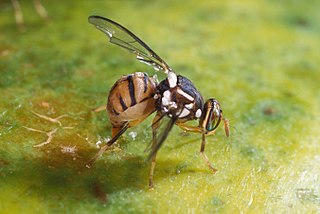 W
WBactrocera dorsalis, previously known as Dacus dorsalis and commonly referred to as the oriental fruit fly, is a species of tephritid fruit fly that is endemic to Southeast Asia. It is one of the major pest species in the genus Bactrocera with a broad host range of cultivated and wild fruits. Male B. dorsalis respond strongly to methyl eugenol, which is used to monitor and estimate populations, as well as to annihilate males as a form of pest control. They are also important pollinators and visitors of wild orchids, Bulbophyllum cheiri and Bulbophyllum vinaceum in Southeast Asia, which lure the flies using methyl eugenol.
 W
WDolichoderus erectilobus is a species of ant in the genus Dolichoderus. Described by Santschi in 1920, the species is only known to be endemic to Vietnam.
 W
WEuchomenella macrops is a species of praying mantis in the subfamily Deroplatyinae and tribe Euchomenellini.
 W
WEupatorus gracilicornis, the five-horned rhinoceros beetle is a beetle that has four large horns on the prothorax and one extra-long cephalic horn. Rhinoceros beetles, the Dynastinae, are a subfamily of the scarab beetle family (Scarabaeidae).
 W
WHierodula membranacea is the largest praying mantis, sharing its common name giant Asian mantis with other large members of genus Hierodula: of which it is the type species. Its colours vary from green to yellow-green, or even brown to reddish-brown, similar to those of the giant Indian mantis and the giant Malaysian mantis. As the name suggests, it originates from southeast Asia and is among the largest of mantises. Male and female adults reach around 7–9 centimetres (2.8–3.5 in), excluding extended forelegs. It is a cannibalistic species, with the females sometimes eating the males after mating.
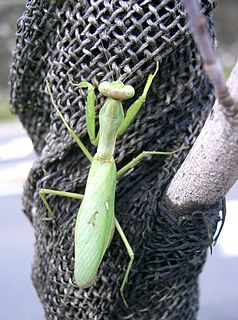 W
WHierodula patellifera, common name giant Asian mantis, Asian mantis, Indochina mantis or Harabiro Mantis, is a species of praying mantis belonging to genus Hierodula.
 W
WHierodula unimaculata is an Asian praying mantis species in the tribe Paramantini.
 W
WHymenopus coronatus, also called H. bicornis, is a mantis from the tropical forests of Southeast Asia. It is known by various common names including walking flower mantis and (pink) orchid mantis. It is one of several species known as flower mantises from their resemblance and behaviour.
 W
WMetallyticus splendidus is a very rare species of praying mantis found in Southeast Asia. It has an iridescent appearance.
 W
WNeocerambyx oenochrous is a species of beetle in the family Cerambycidae, the longhorn beetles. It is native to Asia, where it occurs in China, Vietnam, Laos, and Taiwan. It is known commonly as the cherry tree longhorned beetle and Wushe blood-spotted longhorned beetle.
 W
WOpamyrma hungvuong is a species of ant found in central Vietnam, first described in 2008. It is the only species in the genus Opamyrma.
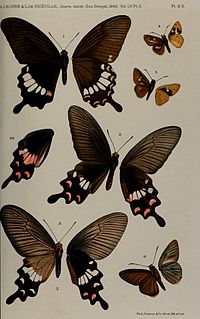 W
WPapilio pitmani is a species of swallowtail butterfly from the genus Papilio that is found in Burma, Thailand and Vietnam.
 W
WPapilio prexaspes, the blue Helen, is a swallowtail butterfly found in Southeast Asia. The race found in the Andaman and Nicobar Islands, Papilio prexaspes andamanicus, is also known as the Andaman Helen.
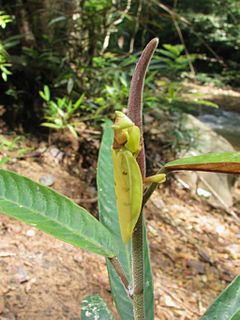 W
WParymenopus davisoni is an insect of the order Mantodea (mantises) from Southeast Asia, including Malaysia and Thailand.
 W
WPhryganistria tamdaoensis is a species of stick insect belonging to the family of giant sticks. It was described in 2014 based on specimens from the Tam Đảo National Park in Vietnam, hence, the specific name tamdaoensis. It was described by Joachim Bresseel and Jérôme Constant, biologists of the Royal Belgian Institute of Natural Sciences (RBINS). In the same paper they also reported the discovery of another new subspecies, Phryganistria heusii yentuensis, which – measuring 32 cm long – is the second biggest insect known to date. In contrast, P. tamdaoensis, measuring only 23 cm long, is one of the smallest species under giant sticks.
 W
WPyrops coelestinus, previously known as Laternaria coelestina, is a species of planthopper belonging to a genus referred-to as lantern-bugs, sometimes known as the blue lantern bug.
 W
WPyrops spinolae is a species of planthopper sometimes referred-to as the dark-horned lantern-fly. The species is named after Maximilian Spinola, the authority for the genus.
 W
WTenodera angustipennis is a species of mantis native to Asia and nearby areas of Oceania. The species was introduced and became established in the eastern United States. Tenodera angustipennis was noticed as early as 1921 in Aberdeen, Maryland, but that occurrence was not noted in a published record until 1933.
 W
WTheopropus elegans, common name banded flower mantis, is a species of praying mantis native to Southeast Asia.
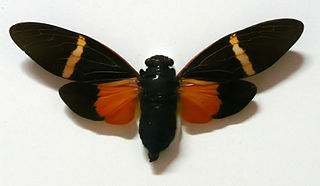 W
WTosena paviei is a cicada species from Southeast Asia. It has been recorded from Thailand and Vietnam. The type specimens(s) were collected on the 'Route de Luang-Prabang à Theng'. Luang Prabang is now in Laos but Theng probably refers to Điện Biên Phủ, a city in the Northwest region of Vietnam near the border with Laos which was formerly called Thaeng or Muong Thanh. So it's not clear if the type specimen(s) were collected in Laos or Vietnam.
 W
WXylocopa aestuans, or Xylocopa (Koptortosoma) aestuans, is a species of carpenter bee. It is widely distributed in Southeast Asia.
 W
WXylocopa caerulea, the blue carpenter bee, is a species of carpenter bee.
 W
WXylocopa latipes, the tropical carpenter bee, is a species of carpenter bee widely dispersed throughout Southeast Asia. As its name suggests, this bee inhabits forests in warm tropical climates and constructs nests by burrowing into wood. It often makes long deep tunnels in wooden rafters, fallen trees, telephone poles and the like, but is not found in living trees.
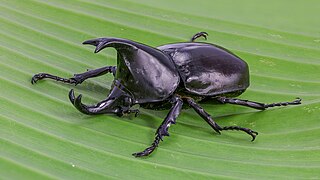 W
WThe Siamese rhinoceros beetle, fighting beetle, Xylotrupes socrates is a brilliant species of large scarab beetle belonging to the subfamily Dynastinae. It is particularly known for its role in insect fighting in Thailand.